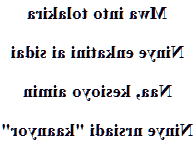Maasai love poem
Mwa into tolakira
Ninye enkatini ai sidai
Naa, kesioyo aimin
Ninye nrsiadi "kaanyor"


→ French poem ←
Maasai people and language
Maasai love poem (Maa, Massaï, Maasai, Masaï, Arusha, Moitanik, Keekonyokie, Matapo, Kimaasai, Parakuyo, Kisonko, Loitai, Wuasinkishu, Baraguyu, Kore, Siria, Damat, Il-Arusha, Kaputiei, Purko, Iloodokilani, Kwavi, Laitokitok, Lumbwa, Arusa, L-Arusha), in the language of the Maasai people mainly in Tanzania and Kenya, between Oloitoktok in the east and Ntimaru in the west.
This idiom that has several variants and less than 1 million speakers.
I am very happy to finally have this translation. It has a strong resonance in our unconscious. Europeans upon meeting them were struck by the warlike qualities of the men and the beauty of their women.
The Masais or Massais are a nilotic population, located on both sides of Kenya and Tanzania. Exclusively nomadic pastoralists and warriors, the Masais were circumscribed in reserves since the beginning of the 20th century, and have retained the family as a basic economic unit. Today they have been divided into two groups, those from the north and those from the south, themselves divided into different clans.
Tradition places their original cradle in the north of Lake Turkana (Lower Nile Valley). Originally, from the 1st millennium and especially from the 15th century, these Nilotics (from around the Nile) moved southwards by plundering the herds they encountered and integrating the Cushitic populations (people of the Horn of Africa) that they meet, to form this people of pastoralist warriors, the Maasai.
They will be at their peak around 1850, and little by little after their meeting with the Europeans will be allocated grazing areas much smaller than the immense territory on which they circulated.
The Maasai are organized in a patriarchal way, and the older ones are the ones to listen to. Their oral tradition transmitted by the elders continues a culture already well eroded by that of Europeans ... this culture remains imbued with magic, shamanism, prophecy and sacrifices for Enkai and of course many festivals and ceremonies during which are told the legends of the community.
It also seems that traditionally their dead peoples are not buried, but left to scavengers.
They were divided into age class, circumcision marking the entry into the class of warriors. This system of age classes, characteristic of Nilotics, is of a linear type, and its main function is to train warriors to combat and discipline.
They were divided into tribes comprising their own warrior company, located in a district, under the aegis of an elected and revocable warlord, who organized raids against the other Masai tribes or neighboring societies with a view to capture livestock. The Masais were divided into patrilineal totemic clans.
Livestock occupied an essential place in their existence, both economic and religious. The wealth of a man among the Masai was measured in the number of head of cattle, and the inheritance of the livestock was carried out in agnatic line, and the matrimonial compensation was paid with cattle.